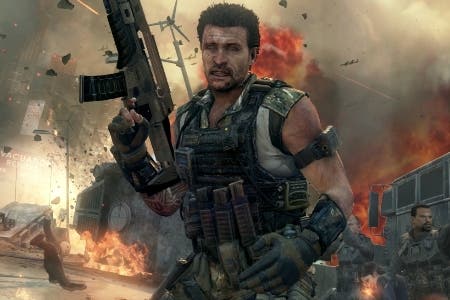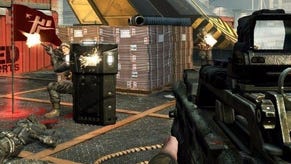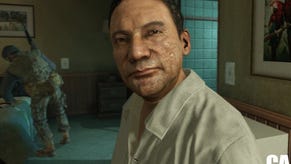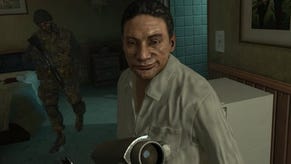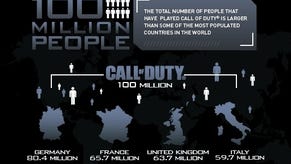Face-Off: Call of Duty: Black Ops 2 on Wii U
The COD experience fails to impress on Nintendo's new hardware.
So let's recap. What we know of the Wii U spec strongly suggests that the new Nintendo machine should be something along the lines of an enhanced Xbox 360. We have a tri-core IBM CPU, an improved, more modern AMD Radeon graphics core, twice as much RAM available to developers and we even see a substantial boost in the volume of fast eDRAM directly attached to the GPU. There are trade-offs in any console design, but the key ingredients suggest that 360 ports should transition across to the new hardware fairly easily. Unfortunately, Call of Duty: Black Ops 2 proves that the situation is not quite so straightforward.
Based on a visual analysis at least, it seems clear that developer Treyarch thought its best bet in bringing Black Ops 2 to the Wii U was to transplant its existing Xbox 360 work lock, stock and barrel across to the new hardware. In putting together our usual comparison videos and galleries, what struck us was the level of parity between the 360 and Wii U games - aside from gamma issues, we're essentially looking at exactly the same presentation.
All of this means that the new version gets the same 880x720 native resolution, with the same sharp upscaling filter employed on the Xbox 360 release. There's even 2x multi-sampling anti-aliasing (MSAA) - the first time we've seen hardware AA deployed in-game on a Wii U title (admittedly, it's early days there).
To illustrate how close it is, and how the Wii U version of Black Ops 2 sits within the hierarchy of releases available, we've put together an exhaustive series of comparison videos. Here you'll see Black Ops 2 on Wii U compared with Xbox 360, PS3 and PC versions. We also have our first quad format comparison gallery for you to pore over.
Our PC and Xbox 360 assets are based on our work on the existing Black Ops 2 Face-Off, but as Treyarch has released a patch to remove some of the excessive blurring from the PlayStation 3 game, we went back and recaptured that in order to give the most up-to-date comparisons (the original Face-Off has been updated too with the latest video).
Pretty much everything we said about the image quality on Xbox 360 in the original Face-Off applies here with the Wii U version - it's a remarkably close conversion, from a visual perspective at least. While the PC game provides the benchmark, Treyarch's upscaling algorithms work just as well as they do on Xbox 360, providing a good, clean presentation - quite remarkable bearing in mind just how extensive the horizontal upscale actually is. Despite the removal of the additional blurring added in the 1.02 patch, both Wii U and 360 are still a class apart from the more compromised PlayStation 3 version. One minor difference concerns v-sync - the Wii U version has no tearing whatsoever, while the PS3 and 360 games occasionally tear right at the top of the screen (this is basically unnoticeable during gameplay though).
"Black Ops 2 on Wii U appears to have much in common with the Xbox 360 version including a native 880x720 resolution with 2x MSAA."
Alternative comparisons:
Performance analysis - Wii U struggles to compete
So far, so good. In terms of visual quality, Wii U has established itself alongside the more refined of the two HD console versions. Unfortunately, when it comes to performance, the Wii U release has some serious issues, falling way short of the locked 60FPS goal both Infinity Ward and Treyarch aim for in their Call of Duty offerings. This can be illustrated fairly easily: our existing PS3/360/PC Face-Off features two console analysis videos - the first features like-for-like footage, based mostly on engine-driven cut-scenes and environment traversal, while a second test concentrates on raw gameplay captures culled from the same areas, and is more indicative of in-game performance. We de-archived those streams and added Wii U to the mix.
First up, let's take a look at the like-for-like video, which allows us to directly compare engine performance when the renderer of each version is being subjected to almost identical levels of stress. The results are very interesting indeed, reaffirming the Xbox 360's dominance in terms of performance and leaving the Wii U and PlayStation 3 battling it out for the runner-up position.
What's interesting about the read-out overall is that similar events can stress all three engines, but it's the extent to which frame-rates are impacted that varies dramatically. The initial scene doesn't look too promising for Wii U: indeed, we see three distinct performance bands - Xbox 360 at the top, PS3 in the middle and the new Nintendo console right at the bottom. It's clear that plenty of characters and full-screen transparencies are particular Achilles Heels for the Wii U, a state of affairs that persists in further clips later on. However, beyond that we see a fairly close match for the PlayStation 3 version in other scenarios and occasionally it even pulls ahead of the Sony platform.
"The cut-scene and traversal comparison brutally highlights the areas in which Wii U struggles to match the Xbox 360 - high levels of on-screen characters clearly cause issues."
In every COD game we've looked at since Infinity Ward's groundbreaking work in the original Modern Warfare, we've seen an Xbox 360 advantage over the PlayStation 3 versions. Up until now, our supposition has been that the architecture thrives on the more powerful Xenos graphics core in the Microsoft platform. However, in Wii U we now find ourselves looking at a console with what we're told possesses a significant bump in GPU performance over the old AMD design in the 360, and yet the veteran hardware still commands an easy lead. Lack of experience with the new console and work-in-progress dev tools will play a part in these results, but it could well be that the Wii U's lacklustre CPU is also a contributory factor.
Looking at the gameplay analysis lends a lot more weight to that theory, with the general gulf in performance between the Wii U and the PS3/360 versions opening up significantly. Like-for-like video is great for direct comparisons in engine performance, but actual in-game analysis obviously has more relevance to how well the game plays. This is crucial for Call of Duty, where the interface between player and machine is defined by the low latency controls, which in turn are governed by the 60FPS target frame-rate. The Xbox 360's performance continues to dominate, but the gap does close a little here with PlayStation 3. Unfortunately, the opposite is true with Wii U, which struggles palpably in any scene where a lot of characters are in the area, or when taxing effects work is at play.
On a general level, Treyarch's work with the single-player campaign is ambitious - certainly in terms of concept, but definitely with regards to technology: exceptional dynamic lighting, some beautiful effects work, enclosed interior and sprawling exterior locations along with superb character rendering are just some of the highlights. For a game to look this good and to run at a perceptual 60FPS on console is a substantial achievement - but the fact that the Wii U falls so short of the expected standard during gameplay is a real disappointment.
"In the more ambitious campaign levels, the Wii U has real issues getting close to Xbox 360 and PlayStation 3 levels of performance. Frame-rates are highly variable."
Perhaps the biggest takeaway from the video is to look at the Wii U version in isolation and to take in the peaks and troughs - the delta here is often immense, and clearly more pronounced than it is on the Xbox 360 and PlayStation 3. Lower frame-rates translate directly into muggier response from the controls, but players can "acclimatise" to higher levels of input lag and it won't bother them so much - generally speaking, consistency is the key. The problem with Black Ops 2 on Wii U is that the variance is so dramatic and changes so often that poor response becomes that much more apparent than it does on the other platforms. We had concerns that stereo 3D would be a complete write-off based on these results (3D already features a substantial frame-rate hit on both 360 and PS3) but the feature is omitted on Wii U, which is perhaps for the best.
There is some good news, however. In terms of rendering, the multiplayer component of the game poses far fewer challenges than the campaign, meaning that you get an experience that is very, very close to the Xbox 360 and PlayStation 3 versions of the game. You just need to bear in mind that the Wii U's online community is pretty sparse at the moment, and that COD may not be its focus. To put things into perspective, during our online testing there were 321,502 concurrent players online with the PlayStation 3 version of the game. Curiously, that beat out the Xbox 360 version, which clocked in at 282,683. The Wii U version could only boast 452 players. Now granted, the Wii U has only just been released in the US and the timezone difference would factor into that. While we would expect that number to grow significantly once the system is out in Europe, it's safe to say that the community isn't really there yet. This may not necessarily be a bad thing - it may even give those with little COD experience an easier ride as they get to know the game, but it does mean that there's a ghost-town feel to some of the modes.
Black Ops 2 - what does the tablet do?
For the duration of the single-player campaign, it's fair to say that the GamePad isn't exactly put to much use. However, you can mirror the HDTV output onto the tablet display at any point, meaning that in a living room environment you don't need to hog the main screen; you can detach at any point and continue to play simply by pressing an on-screen button on the touch-screen. As we mentioned in the main Wii U review, range is generally pretty good and the GamePad works through walls too, to a certain extent at least. It's a feature that isn't deployed on every game for obvious reasons, but where PS3/360 ports are concerned, we'd definitely like to see it implemented as standard.
Bearing in mind that Black Ops 2 runs with a somewhat variable frame-rate (in contrast to New Super Mario Bros U, which is locked to 60Hz), we thought this would be a good opportunity to see if the mirroring function incurs any kind of further performance hit when the system is servicing two screens. Mobile hardware tends to have bandwidth issues resulting in frame-rate drops when external mirroring is enabled, but the good news is that we could spot no difference at all on Wii U when we analysed HDMI streams running with mirroring both enabled and disabled.
"Does GamePad mirroring impact on Wii U system performance? Thankfully, evidence suggests not."

In multiplayer modes, the tablet does gain some additional functionality. The mini-map runs on the touch-screen, you can adjust classes without pressing the start button and you can even access ScoreStreaks too. It sounds like a good bonus, but in some cases we see the same problem here that we find with many of the other Wii U titles - it's a matter of focus. Making use of the touch-screen functionality in-game takes away your attention from the main screen where gameplay is hosted - effectively making you vulnerable at those points.
Where Treyarch deserves credit is for the expansion to the local multiplayer options, specifically in terms of split-screen. While the standard two-player mode of the existing console version is supported, the Wii U has an excellent alternative: discrete screens for each participant - HDTV output for one player, GamePad for the other.
This mode - indeed, split-screen in general - is not without its trades. Frame-rate definitely takes a hit (which varies according to the map and definitely muddies controller response), but resolution is maintained and the only noticeable visual downgrade comes from the removal of dynamic shadows. Even this isn't quite as impactful as it sounds as shadows "baked" into the environments are still there.
"Tablet usage could have been better in the campaign but the multiplayer split-screen situation is impressive - one gamer takes the main screen while the other uses the tablet."

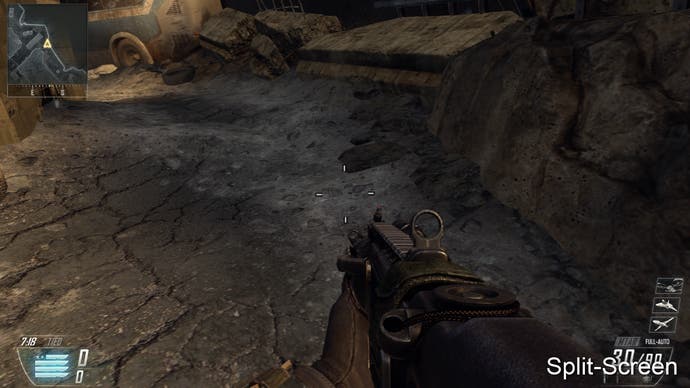
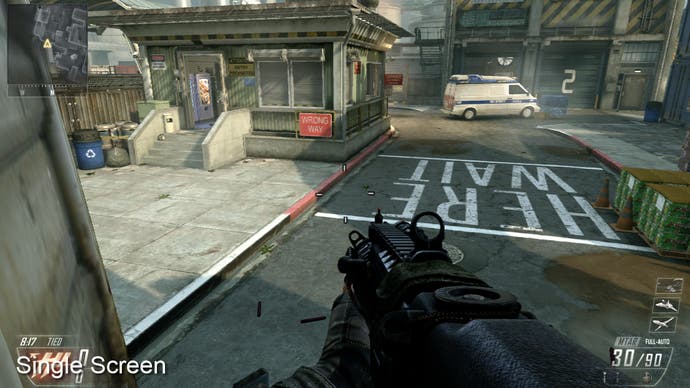

Call of Duty: Black Ops 2 on Wii U - the Digital Foundry verdict
Speaking to a developer the other day, we heard a story that Treyarch put so much effort into optimising for console that the original Black Ops left just 1MB of free disc space on the Xbox 360 DVD. It's indicative of the ways in which studios are pushing the current hardware to its limits, and with Black Ops 2 it's clear that Treyarch has put even more effort into optimising results for the current-gen platforms to the point where the single-player campaign is a truly remarkable technical achievement and a fantastic slice of gunplay to boot.
The Wii U version matches the look of the Xbox 360 game and thus gives it an edge visually over the PlayStation 3 release, but unfortunately it comes up well short in terms of performance - an aspect that is all-important to the playability of a COD title. The frame-rate variance is such that the PS3 game feels generally smoother, while the 360 release feels like an entirely different game in the more demanding levels. Bearing in mind the commonalities in hardware design between Wii U and Xbox 360, we can't help but feel somewhat disappointed that Black Ops 2 under-performs so noticeably.
True, Treyarch have had years to optimise the COD engine for Xbox 360 and PlayStation 3 and would not have had this luxury in preparing the game for Wii U. Furthermore, on a basic level, Black Ops 2 itself would have been designed with no regard for the Nintendo hardware. That said, we find it hard to blame the developer here - we have seen generational leaps in CPU, GPU and RAM technology since the launch of the Xbox 360 seven years ago, and for the Wii U hardware to under-perform to this extent on such a crucially important game doesn't look good for future prospects. Bearing in mind the specific areas that are causing the most noticeable dips in performance, once again it looks like the CPU is the main bottleneck.
Still, on the plus side, the multiplayer component of the game has emerged unscathed - if that's your focus, and you're willing to be patient for the online audience to grow in number, Black Ops 2 on Wii U is still worthy of consideration. The game also illustrates rather nicely the application of the GamePad for a new form of split-screen gaming, while tablet mirroring really is a sweet feature that we hope more developers embrace.
